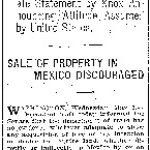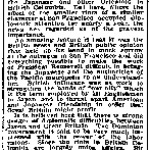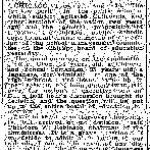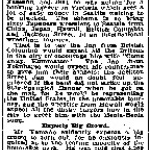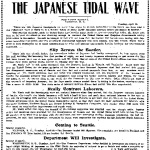James D. Phelan
| Name | James Duval Phelan |
|---|---|
| Born | April 20 1861 |
| Died | August 7 1930 |
| Birth Location | San Francisco, CA |
Banker, philanthropist, and politician. A wealthy mayor of San Francisco and U.S. Senator representing California, James D. Phelan (1861–1930) was also one of the leaders of the second wave of anti-Japanese agitation that culminated in the ending of Japanese immigration to the U.S. through the Immigration Act of 1924 .
Reform Leader
James Duval Phelan was born on April 20, 1861 in San Francisco to James Phelan and Alice Kelly Phelan. His father had been born in Ireland and made his way to San Francisco during the California Gold Rush, becoming a millionaire in the process. Young James grew up in an atmosphere of privilege and where his family's Irish heritage and Catholic faith were celebrated. He attended Saint Ignatius College, graduating in 1881 and attended Hastings School of Law before traveling in Europe for two years. Inspired by the great cities of Europe, he returned with a dream that San Francisco might be remade in their style.
He became a successful banker and, encouraged by San Francisco Bulletin editor Fremont Older, ran successfully for mayor in 1897 on a reform platform. By most accounts, he succeeded in curbing corruption and in streamlining city government. Believing that private ownership of utilities encouraged corruption, he promulgated a new city charter in 1898 that brought public ownership of utilities. But labor issues—most notably his authorization of police protection for strikebreakers in a massive 1901 strike—marred the latter part of his tenure, and he opted not to run again in 1901. His leaving office opened the door for the election of the corrupt Eugene E. Schmitz as his successor.
After leaving office, Phelan formed the Association for the Improvement and Adornment of San Francisco in 1904, sponsoring the development of a city plan for San Francisco. He also advocated and helped finance an investigation of corrupt city government that led to the conviction of Schmitz on extortion charges and his leaving office. Described by California historian Kevin Starr as "a smaller, dapper man, his beard well trimmed, his tailoring impeccable, a lifelong, very ardent and discreet wooer of the ladies," Phelan lived in the lavish Villa Montalvo mansion and was active in the San Francisco arts and social scene. [1]
He reentered the political arena in the 1910s, establishing himself as the "leader of the established Democratic organization in California from 1912 until his death in 1930," according to historian Robert E. Hennings. [2] He won election to the U.S. Senate in 1914, his victory ending a long Republican reign made possible by a split among the Republicans.
Anti-Japanese Leader
Phelan's anti-Japanese credentials date back to his time as mayor, when he was a featured speaker at one of the first large anti-Japanese protests in California in 1900. In 1912, he supported Woodrow Wilson for president, but only after getting Wilson to commit to supporting Japanese exclusion. Phelan also supported alien land law legislation in 1913. He was an early adopter of the idea that Japanese immigrants were a danger because Japan represented a military threat to the U.S., the notion of the "yellow peril." Similar arguments would be raised as justification for removing and imprisoning Japanese Americans during World War II.
Since Japan was an ally of the U.S. during World War I, anti-Japanese activity cooled down for a while. But in 1919, Phelan's speech before a special session of the state legislature highlighting yellow peril rhetoric and pushing for Japanese exclusion was key in reinvigorating the movement. Phelan made Japanese exclusion one of the centerpieces of his senate reelection campaign, with the slogan "Keep California White."
Phelan's anti-Japanese philosophy was based on racism, but also on a grudging respect for the Japanese. It was because Japanese were "capable of taking the place of the White man" and could not "be treated as the negro," that they were a particular threat and thus dangerous. [3]
Though he was defeated in his 1920 reelection bid in the face of a Republican landslide, he continued to press for Japanese exclusion, largely in collaboration with wealthy retired publisher V.S. McClatchy . His efforts were vindicated by the passage of the Immigration Act of 1924, which banned Japanese immigration.
Phelan remained the de facto leader of the California Democratic Party through the 1920s, resisting entreaties to run for governor or senator in 1922 and 1924. Suffering health problems in the later years of the decade, he died at Villa Montalvo on August 7, 1930.
For More Information
Daniels, Roger. The Politics of Prejudice: The Anti-Japanese Movement in California and the Struggle for Japanese Exclusion . 1962. 2nd edition. Berkeley: University of California Press, 1977.
Hennings, Robert E. James D. Phelan and the Wilson Progressives of California . New York: Garland, 1985.
Starr, Kevin. Americans and the California Dream, 1850–1915 . New York: Oxford University Press, 1973.
———. Inventing the Dream: California Through the Progressive Era . New York: Oxford University Press, 1985.
Van Nuys, Frank W. “Sowing the Seeds of Internment: James D. Phelan’s Anti-Japanese Crusade, 1919-1920.” In Remembering Heart Mountain: Essays on Japanese American Internment in Wyoming . Ed. and contribution by Mike Mackey. Powell, Wyoming: Western History Publications, 1998. 1-16.
Footnotes
- ↑ Kevin Starr, Inventing the Dream: California Through the Progressive Era (New York: Oxford University Press, 1985), 242.
- ↑ Robert E. Hennings, "California Democratic Politics in the Period of Republican Ascendancy," Pacific Historical Review 31.3 (August 1962), 268.
- ↑ Roger Daniels, The Politics of Prejudice: The Anti-Japanese Movement in California and the Struggle for Japanese Exclusion , 2nd ed. (Berkeley: University of California Press, 1977), 83.
Last updated Aug. 28, 2013, 3:54 a.m..

